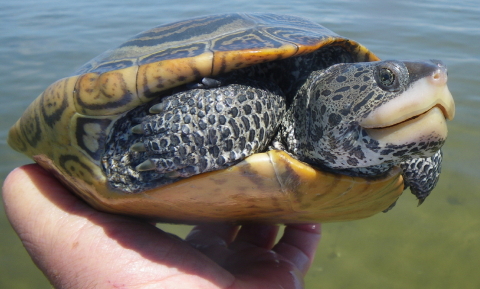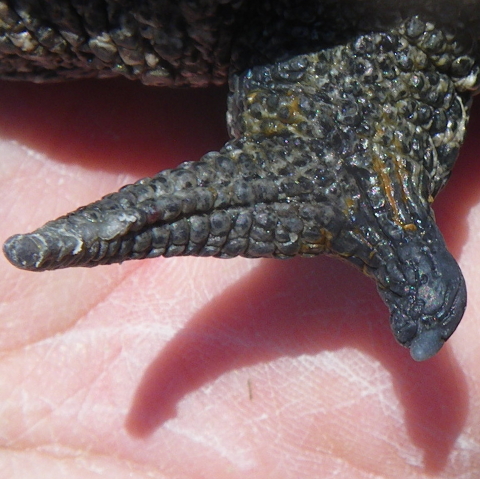
Male Snapping Turtle at SouthCoast Bog
For the Turtle Journal team, Spring isn’t really Spring until snapping turtles begin to prowl, looking for love in all the right and wrong places. And when you’re a mature male snapping turtle, like the handsome critter above, no one is foolish enough to tell you that you’re in the wrong place.

First Prowling Snapper at Washburn Park
Sue Wieber Nourse and Rufus encountered the first snapper on the prowl on Friday, May 3rd. This healthy and feisty male emerged from swampy wetlands to cross the walking path into the large reservoir at Washburn Park. He was particularly unamused to find Sue and Rufus in his way, and he employed Darth Vader-like hissing and multiple power snaps to clear these inconvenient mammalian obstacles from his determined path. You may know that a snapper turtle’s neck can stretch (a.k.a. snap) nearly half the length of its shell quicker than human brain and body can react.

Male Snapping Turtle in SouthCoast Bog
On Saturday, we visited a large, quiet SouthCoast cranberry bog for another chance to see these living prehistoric fossils in action. We walked along bog channels and peered into a deep mucky “elbow” pool. Through the murk we could just make out the spooky shape of a giant shelled reptile lying on the bottom, something straight from the Jurassic era as though beamed through the ages by an H.G. Wells Time Machine.

“You’re Gonna Need a Bigger Net!”
Don Lewis carried his trusty sampling net, jerry-rigged with a long, eight foot extension pole. He scooted down the bank and scooped the large snapper from the murky water. Normally used for capturing terrapins and small fresh water turtles, the poor net bowed and groaned under the weight and the fight response of this impressive reptile. In the back of his head, Don heard echoes of Jaws’ Chief Brody, “You’re gonna need a bigger net!”

Rufus Gives Snapper a Wide Berth
Nevertheless, Don lifted the snapper to the top of the bank where Rufus had supervised the struggle. She decided to give this aggressive critter a wide berth and to let humans handle the situation.

Snapping Turtle Plastron
One reason I believe that snappers are so aggressive, compared to terrapins and box turtles and painted turtles and spotted turtles, is the small plastron that guards its underbelly. Unlike those other species that are well protected by a hard shell from potential predators, snappers’ soft meaty parts are exposed and vulnerable. Best strategy for a snapper is to force potential threats to keep their distance with a powerful snap and claws the thickness and the strength of railroad spikes. Does a Tyrrannosaurus rex come to mind?

Snapping Turtle’s Dinosaur-Like Tail
Snappers have an extraordinary tail that seems straight from the dinosaur design book. The humps and bumps along its luxurious length remind us of a sauropod, as does its thickness and strength. Next to a chomp from its snappy jaws and a tear from its steely claws, our least favorite choice would be to sustain the whip of its powerful dinosaur-like tail.

Male Snapping Turtle Up Close and Personal
Whatever the rationale for their aggresssive behavior, Turtle Journal must admit that it seems to work very well … for perhaps 200 million years. Few folks and even fewer critters  have the infinite bravado and the infintesimal good sense to confront an angry snapping turtle without utmost caution and protection. The Turtle Journal team finds snapping turtles irresistible reminders of a time long, long forgotten. They remain near the top of our list of favorite turtle species.

















